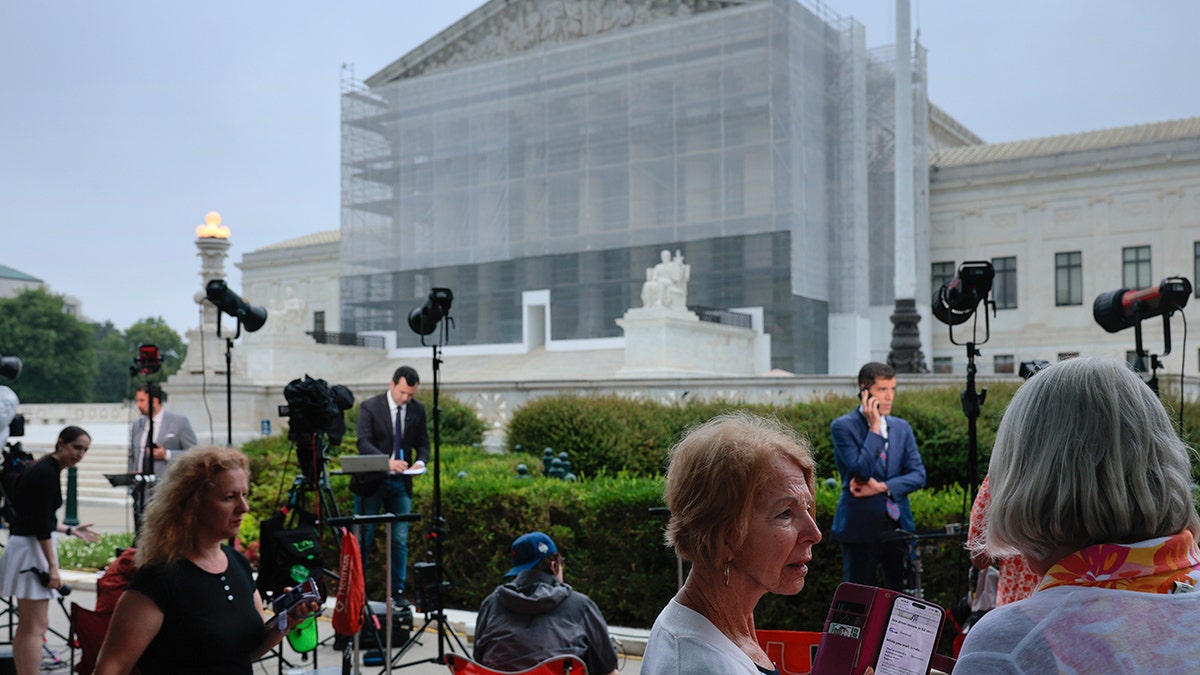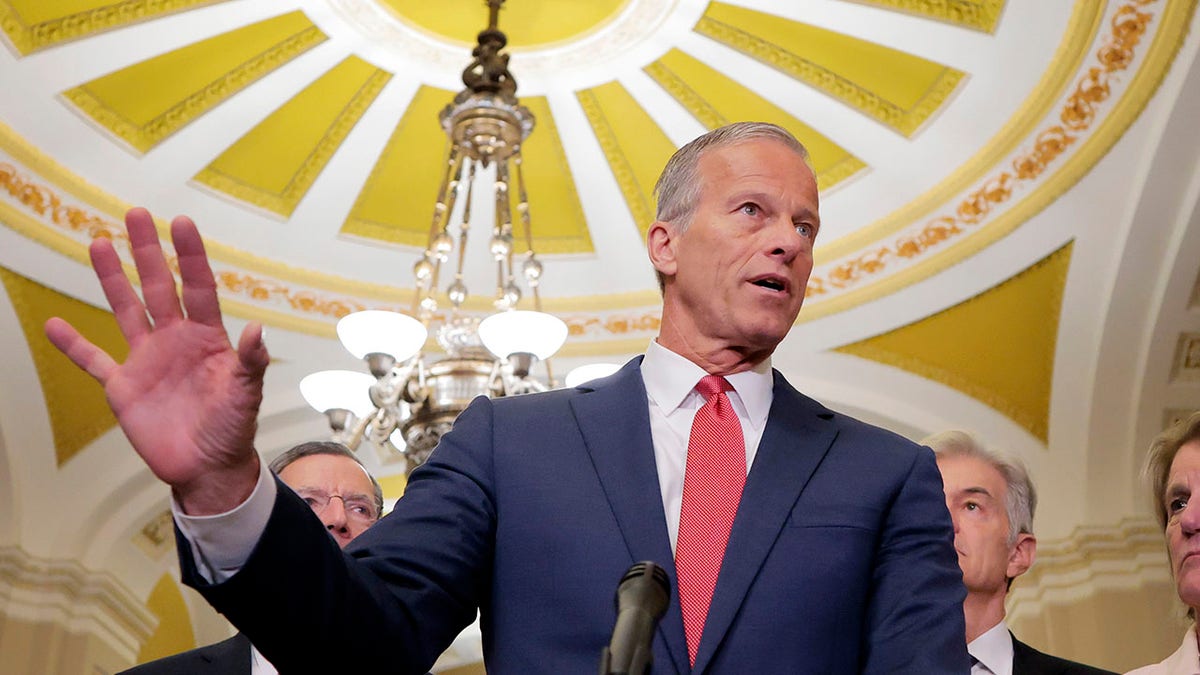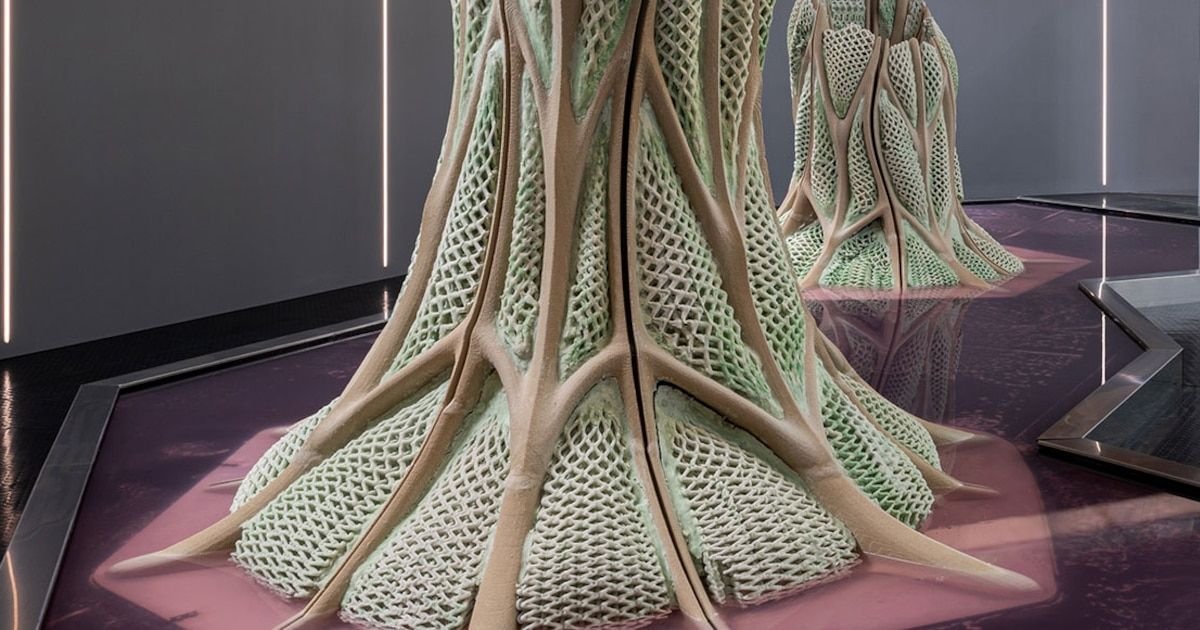INTERNACIONAL
ACLU sues Trump over birthright order as Supreme Court clears path for it to take effect

NEWYou can now listen to Fox News articles!
Hours after the Supreme Court delivered the Trump administration a major victory Friday by ruling lower courts may issue nationwide injunctions only in limited instances, a coalition of liberal legal groups filed a sweeping new class-action lawsuit in New Hampshire federal court. It takes aim at President Donald Trump’s January executive order that redefines who qualifies for U.S. citizenship at birth.
While the justices’ 6-3 ruling leaves open the question of how the ruling will apply to the birthright citizenship order at the heart of the case, Friday’s lawsuit accuses the administration of violating the Constitution by denying citizenship to children born on U.S. soil if their mothers are either unlawfully present or temporarily in the country and their fathers are not U.S. citizens or lawful permanent residents.
The case was brought by the American Civil Liberties Union, ACLU of New Hampshire, ACLU of Maine, ACLU of Massachusetts, Legal Defense Fund, Asian Law Caucus and Democracy Defenders Fund. It seeks to represent a proposed class of children born under the terms of the executive order and their parents.
UPENDING US BIRTHRIGHT CITIZENSHIP WOULD HAVE DRASTIC NEGATIVE IMPACT, DEFENDERS WARN
President Donald Trump answers questions during a news conference on recent Supreme Court rulings Friday in the briefing room at the White House. (Joe Raedle/Getty Images)
It is not the first legal challenge to the policy. The same group filed a separate suit in January 2025 in the same court on behalf of advocacy organizations with members expecting children who would be denied citizenship under the order. That case led to a ruling protecting members of those groups and is now pending before the 1st Circuit Court of Appeals, with oral arguments scheduled for Aug. 1.
Friday’s SCOTUS ruling states that lower courts can no longer block federal policies nationwide unless it’s absolutely necessary to give full relief to the people suing. The decision does not say whether Trump’s birthright citizenship order is legal, but it means the order could take effect in parts of the country while legal challenges continue. The court gave lower courts 30 days to review their existing rulings.
«The applications do not raise — and thus we do not address — the question whether the Executive Order violates the Citizenship Clause or Nationality Act,» Justice Amy Coney Barrett said, writing for the majority. «The issue before us is one of remedy: whether, under the Judiciary Act of 1789, federal courts have equitable authority to issue universal injunctions.»
«A universal injunction can be justified only as an exercise of equitable authority, yet Congress has granted federal courts no such power,» she added.
SUPREME COURT TAKES ON BIRTHRIGHT CITIZENSHIP: LIBERALS BALK AT TRUMP ARGUMENT TO END NATIONWIDE INJUNCTIONS

President Donald Trump, joined by Attorney General Pam Bondi and Deputy Attorney General Todd Blanche, addresses recent Supreme Court rulings with members of the press in the briefing room at the White House Friday in Washington, D.C. (Joe Raedle/Getty Images)
Justice Sonia Sotomayor, in her dissent, suggested plaintiffs could pursue class actions as an alternative.
«Nevertheless, the parents of children covered by the Citizenship Order would be well advised to file promptly class action suits and to request temporary injunctive relief for the putative class pending class certification,» Sotomayor wrote. «For suits challenging policies as blatantly unlawful and harmful as the Citizenship Order, moreover, lower courts would be wise to act swiftly on such requests for relief and to adjudicate the cases as quickly as they can so as to enable this Court’s prompt review.»
The ACLU lawsuit calls birthright citizenship «America’s most fundamental promise» and claims the executive order threatens to create «a permanent, multigenerational subclass» of children denied legal recognition.
«The Supreme Court’s decision did not remotely suggest otherwise, and we are fighting to make sure President Trump cannot trample on the citizenship rights of a single child,» said Cody Wofsy, deputy director of the ACLU’s Immigrants’ Rights Project and lead attorney in the case.

Members of the media stand in front of the Supreme Court building in Washington, D.C., on the final day of this term on Friday. (Chip Somodevilla/Getty Images)
«This executive order directly opposes our Constitution, values, and history,» added Devon Chaffee, executive director of the ACLU of New Hampshire. «No politician can ever decide who among those born in our country is worthy of citizenship.»
The lawsuit cites the 14th Amendment, which provides that «all persons born or naturalized in the United States, and subject to the jurisdiction thereof, are citizens.» It also references the Supreme Court’s 1898 decision in United States v. Wong Kim Ark, which affirmed birthright citizenship for U.S.-born children of noncitizens.
The plaintiffs include individuals from Honduras, Taiwan and Brazil. One mother in New Hampshire is expecting her fourth child and fears the baby will be denied citizenship despite being born in the U.S.
The case is Barbara et al. v. Trump et al., No. 1:25-cv-244, filed in the U.S. District Court for the District of New Hampshire.
«Trump’s executive order directly opposes our Constitution, values, and history and it would create a permanent, multigenerational subclass of people born in the U.S. but who are denied full rights,» said SangYeob Kim of the ACLU of New Hampshire in January.
CLICK HERE TO GET THE FOX NEWS APP
«Today’s historic decision delivers a decisive rejection of the weaponized lawfare President Trump has endured from leftist activist judges who attempted to deny the president his constitutional authority,» White House spokesperson Liz Huston wrote to Fox News Digital.
«President Trump will continue to implement his America First agenda, and the Trump Administration looks forward to litigating the merits of the birthright citizenship issue to ensure we secure our borders and Make America Safe Again.»
Fox News Digital’s Breanne Deppisch contributed to this report.
INTERNACIONAL
Trump’s ‘big, beautiful bill’ faces Republican family feud as Senate reveals its final text

NEWYou can now listen to Fox News articles!
Senate Republicans unveiled their long-awaited version of President Donald Trump’s «big, beautiful bill,» but its survival is not guaranteed.
Senate Budget Committee Chair Lindsey Graham, R-S.C., revealed the stitched-together text of the colossal bill late Firday night.
The final product from the upper chamber is the culmination of a roughly month-long sprint to take the House GOP’s version of the bill and mold and change it. The colossal package includes separate pieces and parts from 10 Senate committees. With the introduction of the bill, a simple procedural hurdle must be passed in order to begin the countdown to final passage.
When that comes remains an open question. Senate Republicans left their daily lunch on Friday under the assumption that a vote could be teed up as early as noon on Saturday.
HOUSE CONSERVATIVES GO TO WAR WITH SENATE OVER TRUMP’S ‘BIG, BEAUTIFUL BILL’
President Donald Trump on June 18, 2025. (BRENDAN SMIALOWSKI/AFP via Getty Images)
Sen. John Kennedy, R-La., told Fox News Digital that he had «strongly encouraged» Senate Majority Leader John Thune, R-S.D., to put the bill on the floor for a vote Saturday afternoon.
«If you’re unhappy with that, you’re welcome to fill out a hurt feelings report, and we will review it carefully later,» Kennedy said. «But in the meantime, it’s time to start voting.»
But Senate Republicans’ desire to impose their will on the package and make changes to already divisive policy tweaks in the House GOP’s offering could doom the bill and derail Thune’s ambitious timeline to get it on Trump’s desk by the July 4 deadline.
However, Thune has remained firm that lawmakers would stay on course and deliver the bill to Trump by Independence Day.
When asked if he had the vote to move the package forward, Thune said «we’ll find out tomorrow.»
TOP TRUMP HEALTH OFFICIAL SLAMS DEMOCRATS FOR ‘MISLEADING’ CLAIMS ABOUT MEDICAID REFORM
But it wasn’t just lawmakers who nearly derailed the bill. The Senate parliamentarian, the true final arbiter of the bill, ruled that numerous GOP-authored provisions did not pass muster with Senate rules.
Any item in the «big, beautiful bill» must comport with the Byrd Rule, which governs the budget reconciliation process and allows for a party in power to ram legislation through the Senate while skirting the 60-vote filibuster threshold.

Senate Majority Leader John Thune speaks during a news conference following the weekly Senate Republican policy luncheon at the U.S. Capitol on June 17, 2025, in Washington. (Getty Images)
That sent lawmakers back to the drawing board on a slew of policy tweaks, including the Senate’s changes to the Medicaid provider tax rate, cost-sharing for food benefits and others.
Republican leaders, the White House and disparate factions within the Senate and House GOP have been meeting to find middle ground on other pain points, like tweaking the caps on state and local tax (SALT) deductions.
While the controversial Medicaid provider tax rate change remained largely the same, a $25 billion rural hospital stabilization fund was included in the bill to help attract possible holdouts that have raised concerns that the rate change would shutter rural hospitals throughout the country.
On the SALT front, there appeared to be a breakthrough on Friday. A source told Fox News that the White House and House were on board with a new plan that would keep the $40,000 cap from the House’s bill and have it reduced back down to $10,000 after five years.
But Senate Republicans are the ones that must accept it at this stage. Sen. Markwayne Mullin, R-Okla., has acted as the mediator in those negotiations, and said that he was unsure if any of his colleagues «love it.»
«But I think, as I’ve said before, I want to make sure we have enough that people can vote for than to vote against,» he said.
Still, a laundry list of other pocket issues and concerns over just how deep spending cuts in the bill go have conservatives and moderates in the House GOP and Senate pounding their chests and vowing to vote against the bill.
Republican leaders remain adamant that they will finish the mammoth package and are gambling that some lawmakers standing against the bill will buckle under the pressure from the White House and the desire to leave Washington for a short break.
Once a motion to proceed is passed, which only requires a simple majority, then begins 20 hours of debate evenly divided between both sides of the aisle.
‘BABY STEPS’: LEADER THUNE DETAILS HIS WORK TO CORRAL REPUBLICANS BEHIND TRUMP’S LEGISLATIVE VISION

House Speaker Mike Johnson speaks during a news conference at the U.S. Capitol Building on April 1, 2025, in Washington. (Anna Moneymaker/Getty Images)
Democratic lawmakers are expected to spend the entirety of their 10 allotted hours, while Republicans will likely clock in well below their limit. From there starts the «vote-a-rama» process, when lawmakers can submit a near-endless number of amendments to the bill. Democrats will likely try to extract as much pain as possible with messaging amendments that won’t actually pass but will add more and more time to the process.
CLICK HERE TO GET THE FOX NEWS APP
Once that is complete, lawmakers will move to a final vote. If successful, the «big, beautiful bill» will again make its way back to the House, where House Speaker Mike Johnson, R-La., will again have to corral dissidents to support the legislation. It barely advanced last month, squeaking by on a one-vote margin.
Treasury Secretary Scott Bessent hammered on the importance of passing Trump’s bill on time. He met with Senate Republicans during their closed-door lunch and spread the message that advancing the colossal tax package would go a long way to giving businesses more certainty in the wake of the president’s tariffs.
«We need certainty,» he said. «With so much uncertainty, and having the bill on the president’s desk by July 4 will give us great tax certainty, and I believe, accelerate the economy in the third quarter of the year.»
INTERNACIONAL
Un hidrogel con cianobacterias podría ser una solución para combatir el cambio climático

Un material puede hacer que las paredes de un edificio ayuden a limpiar el aire que las rodea y a mitigar el problema del cambio climático. Eso no es magia: es el resultado de un avance científico real realizado en una universidad pública de Suiza.
Fue realizado por investigadores de ETH Zurich, la institución que fue fundada en 1855 y tuvo como alumnos al físico Albert Einstein y a otros 21 ganadores de Premios Nobel. Incluyeron cianobacterias dentro de un hidrogel, que es un polímero inerte, y obtuvieron un material vivo artificial.
El nuevo material es capaz de capturar dióxido de carbono (CO₂) de manera eficaz, mientras genera minerales que lo almacenan de forma estable. Los resultados fueron publicados en la revista Nature Communications.

Significa que, además de transformar el CO2 en biomasa a través de la fotosíntesis, las cianobacterias inducen la formación de minerales y así se consigue un almacenamiento mucho más duradero y seguro del carbono capturado en el propio material.
Consideran que la innovación podría ofrecer una solución escalable y sostenible que elimina el CO₂ de la atmósfera al emplear procesos naturales.

El dióxido de carbono siempre ha estado presente en la atmósfera. Es parte natural del aire que se respira y del ciclo del carbono del planeta.
Pero su presencia aumentó por actividades humanas como la quema de combustibles fósiles (petróleo, gas, carbón) y la deforestación.
Este exceso de CO₂ atrapa calor en la atmósfera y eso condujo a que las temperaturas globales suban, los glaciares se derritan, los océanos se calienten, entre otros impactos.
El CO₂ no es “malo” en sí mismo: las plantas lo necesitan para hacer fotosíntesis. Pero en exceso desequilibra el sistema.
Científicos de todo el mundo buscan formas efectivas de capturar ese CO₂ para defender la salud del planeta.

La mayoría de los métodos conocidos hasta ahora son costosos, requieren mucha energía o no consiguen guardar el carbono durante mucho tiempo.
Algunos grupos han probado con técnicas químicas y otros con organismos vivos como plantas y algas.
Pero, hasta este avance, no se había combinado con éxito un material inerte y un organismo vivo que sigue activo dentro del hidrogel y tiene capacidad de almacenar carbono en formas estables.
El equipo de ETH Zurich decidió enfrentar el desafío de hacer algo muy diferente.

Para fabricar el nuevo material, el equipo usó un hidrogel, que es como una esponja blanda hecha con polímeros. Este gel deja pasar agua, luz y CO₂.
Dentro del hidrogel colocaron millones de cianobacterias, microorganismos que viven en la Tierra desde hace millones de años y pueden hacer fotosíntesis.
Las cianobacterias usan la luz solar para transformar el CO₂ del aire en alimento y oxígeno. También producen una reacción especial: su actividad provoca la formación de minerales sólidos, como la cal, que guarda el CO₂ por mucho tiempo dentro del gel.
El equipo utilizó impresión 3D para dar forma al material y optimizar la entrada de luz, agua y nutrientes. Así crearon piezas y bloques que funcionan bien para proyectos grandes.

Dalia Dranseike, quien fue primera autora del trabajo junto con Yifan Cui, explicó: “El material tiene estructuras que dejan pasar luz y distribuyen el líquido con nutrientes gracias a la capilaridad”.
El material logró resultados increíbles: en el laboratorio, pudo atrapar CO₂ de forma constante durante 400 días.
Cada gramo retuvo 26 miligramos de CO₂, y superó a otros métodos como el llamado “hormigón reciclado”. Los minerales que se forman en su interior vuelven el material más fuerte y resistente.
Las posibles aplicaciones van más allá de los experimentos. Los investigadores imaginan que el nuevo material se podría usar en edificios, fachadas y objetos urbanos para limpiar el aire y ayudar a combatir el cambio climático.

Después de los éxitos en el laboratorio, el equipo de ETH Zurich llevó su material a exposiciones internacionales de arquitectura. Andrea Shin Ling, arquitecta y miembro del equipo, fue clave en este paso.
En la Bienal de Arquitectura de Venecia montaron troncos de hasta tres metros de alto, formados por el material vivo que contiene cianobacterias. Cada tronco puede capturar 18 kilos de CO₂ por año, similar a lo que absorbe un pino adulto.
La arquitecta contó que el mayor desafío fue escalar el proceso, ya que fabricar piezas grandes es muy diferente al trabajo de laboratorio.
En tanto, en la Trienal de Milán, cubrieron tejas de madera con el hidrogel y las cianobacterias. Con el tiempo, formaron una “piel” verde sobre la madera, un signo claro de que las bacterias seguían vivas y activas capturando CO₂.
Observar el cambio de color y el trabajo de las cianobacterias resultó emocionante para el equipo.

En diálogo con Infobae, la doctora Graciela Salerno, investigadora superior del Conicet en cianobacterias y biotecnología, profesora emérita de la Universidad Nacional de Mar del Plata y vicepresidente del Comité Ejecutivo de la Fundación para Investigaciones Biológicas Aplicadas (FIBA), comentó: “Se busca desde hace varias décadas en diferentes laboratorios, el desarrollo de métodos de secuestro de dióxido de carbono a través de materiales fotosintéticos”.

Tras leer el estudio publicado en Nature Communications, la doctora Salerno, quien no participó en la investigación, opinó que los investigadores de Suiza “le han dado una vuelta interesante y desarrollaron una innovación que combina el poder de las cianobacterias con ingeniería de materiales”.
Además, la científica expresó: “Si bien falta aún escalar la producción y evaluar su implementación práctica, el hidrogel podría ser una estrategia más para combatir al cambio climático. Por supuesto, también se necesita que se reduzcan las emisiones de gases de efecto de invernadero para no seguir agravando el problema”.
INTERNACIONAL
Para Bezos y Sánchez, una boda de secretos que todos conocen

Manejos
Controles
-

 POLITICA1 día ago
POLITICA1 día agoDesconfianza de los intendentes del PRO sobre el avance de las negociaciones con LLA: “Hasta ahora nadie acercó una propuesta”
-

 POLITICA2 días ago
POLITICA2 días agoJavier Milei apuntó duro al Chiqui Tapia por la eliminación de River y Boca: “Le hace mal al fútbol”
-

 POLITICA2 días ago
POLITICA2 días agoDetuvieron a una funcionaria del Ministerio de la Mujer bonaerense por el ataque a la casa de José Luis Espert























